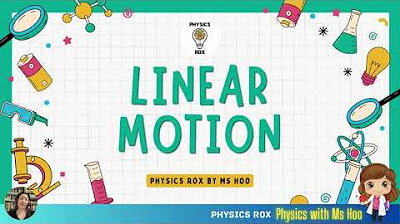Cinemática 02: Deslocamento e distância percorrida
Summary
TLDRIn this educational video, the speaker explains the key differences between displacement and distance traveled. Displacement is a vector quantity that measures the straight-line distance between two points, considering direction, while distance traveled is a scalar quantity representing the total path length covered, regardless of direction. Using an example of traveling between cities, the speaker demonstrates how these concepts differ in real-life situations, highlighting that distance traveled is always greater or equal to displacement. The lesson helps viewers understand how these two concepts are crucial in physics, particularly in the study of motion.
Takeaways
- 😀 Displacement is a vector quantity, meaning it has both magnitude and direction.
- 😀 Displacement is calculated as the difference between the final position (Sₓ) and the initial position (S₀) of an object.
- 😀 Distance traveled is the total length of the path covered, regardless of direction.
- 😀 The formula for displacement is: ΔS = S_f - S_0.
- 😀 Displacement represents the shortest straight-line distance between the starting and ending points.
- 😀 Distance traveled can be longer if the path taken is not a straight line.
- 😀 For example, traveling from city A to city B, via city C, would result in a longer distance traveled but the same displacement.
- 😀 If you travel a round trip, the total distance traveled is the sum of all distances covered, but the displacement may be zero if you return to the starting point.
- 😀 The key difference: Displacement considers direction, while distance traveled does not.
- 😀 Understanding displacement and distance traveled is crucial for solving problems in kinematics, such as calculating velocity or acceleration.
Q & A
What is the primary difference between displacement and distance traveled?
-Displacement is a vector quantity, representing the straight-line distance between two points, with direction. Distance traveled is a scalar quantity, which measures the total path length covered, regardless of direction.
How is displacement calculated?
-Displacement is calculated as the difference between the final position (Sf) and the initial position (S0) of an object. The formula is: Delta S = Sf - S0.
What is the significance of distance traveled in the context of the script?
-Distance traveled refers to the total path covered by an object, including all detours and changes in direction. It is the sum of all the individual segments of the object's movement.
Can displacement ever be greater than the distance traveled?
-No, displacement is always equal to or less than the distance traveled. The only case where they are equal is when the movement occurs in a straight line without any changes in direction.
In the example of traveling from city A to city B, how is distance traveled calculated?
-The distance traveled is the sum of the distances covered in each segment of the journey. For example, if you travel 50 km from city A to city C, and then 60 km from city C to city B, the distance traveled is 50 km + 60 km = 110 km.
What is the displacement when traveling from city A to city B and back to city A?
-The displacement is zero because the starting point and the ending point are the same, meaning there was no net change in position.
Why is displacement considered a vector quantity?
-Displacement is a vector because it has both magnitude (the straight-line distance) and direction (from the starting point to the final destination).
If a traveler goes from city A to city B, detours, and then returns, how is distance traveled calculated?
-Distance traveled is calculated by summing all segments of the path. For instance, if the traveler goes 50 km from city A to city C, 60 km from city C to city B, and then 80 km back to city A, the total distance is 50 km + 60 km + 80 km = 190 km.
How does the concept of displacement change when a traveler returns to their starting point?
-When a traveler returns to their starting point, the displacement becomes zero because the final position is the same as the initial position. However, the distance traveled will still include all the segments of the journey.
What does the symbol 'Delta S' represent in the formula for displacement?
-'Delta S' represents the change in position or displacement, calculated as the difference between the final position (Sf) and the initial position (S0).
Outlines

This section is available to paid users only. Please upgrade to access this part.
Upgrade NowMindmap

This section is available to paid users only. Please upgrade to access this part.
Upgrade NowKeywords

This section is available to paid users only. Please upgrade to access this part.
Upgrade NowHighlights

This section is available to paid users only. Please upgrade to access this part.
Upgrade NowTranscripts

This section is available to paid users only. Please upgrade to access this part.
Upgrade NowBrowse More Related Video

DESCRIBING MOTION: DISTANCE AND DISPLACEMENT | SCIENCE 7 QUARTER 3 MODULE 1

Linear Motion - Distance, Displacement, Speed, Velocity, Acceleration - SPM & IGSCE Physics

Position, Displacement, and Distance - Nerdstudy Physics

Cinemática 14: Velocidade Escalar Média

Gerak Pada Benda: Jarak, Perpindahan, Kelajuan, dan Kecepatan

Introduction to Displacement and the Difference between Displacement and Distance
5.0 / 5 (0 votes)